No-anesthesia cataract surgery defies conventional wisdom
Study finds no significant difference in subjective sensation of pain with or without topical anesthesia.
BANGALORE, India — Cataract surgery can successfully be performed without the use of any anesthetic agents, according to the personal experiences of several practitioners.
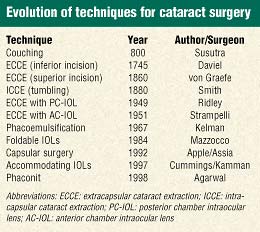 “I am not advocating that every surgeon should perform
no-anesthesia cataract surgery. However, there is something wrong with our
current understanding of the neuroanatomy of the cornea,” said Amar
Agarwal, FRCS, FRCOphth(Lon), director of a group of eye hospitals in Bangalore
and Chennai in India and in Dubai, UAE.
“I am not advocating that every surgeon should perform
no-anesthesia cataract surgery. However, there is something wrong with our
current understanding of the neuroanatomy of the cornea,” said Amar
Agarwal, FRCS, FRCOphth(Lon), director of a group of eye hospitals in Bangalore
and Chennai in India and in Dubai, UAE.
Dr. Agarwal began performing no-anesthesia cataract surgery in June 1998, and to date has completed more than 5,000 cases. He said that a peribulbar block may be advisable if the patient has a shallow anterior chamber or an extremely dense cataract. “But overall, there is no difference in patient comfort among topical, topical with intracameral anesthetic, and no anesthesia,” Dr. Agarwal said.
There are also disadvantages to using topical and intracameral anesthetic solutions. Specifically, topical anesthesia may lead to microbial contamination and corneal epithelial, corneal endothelial or retinal toxicity.
“I had one patient who was allergic to xylocaine,” Dr. Agarwal said. “The anethesist refused to administer a general anesthetic.” Further, “a local anesthetic or topical could not be given because the patient had previously developed a shock with topical anesthetic drops. It ended up that the patient was successfully operated on without any anesthesia. The point is that we have to rework the anatomy of the cornea to understand why this works.”
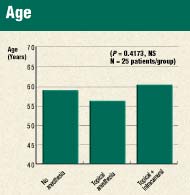 | 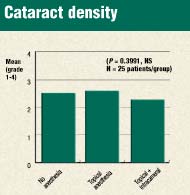 |
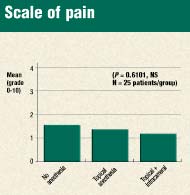 |
No patient complaint
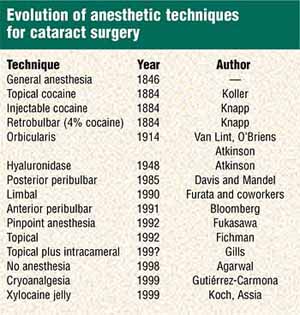 Virgílio Centurion, MD, a cataract
surgeon in Sao Paulo, Brazil, performed one of his first no-anesthesia
operations at the Asian Cataract and Refractive Surgery Convention in Bangalore
in February 1999. “It was a live surgery,” Dr. Centurion said.
“The cataract was very hard with a small pupil. The whole surgery took me
about 10 minutes. The technique was a clear corneal incision, divide and
conquer, and implantation of an SI40 (Allergan) lens with unfolder. There was
no pain complaint from the patient.”
Virgílio Centurion, MD, a cataract
surgeon in Sao Paulo, Brazil, performed one of his first no-anesthesia
operations at the Asian Cataract and Refractive Surgery Convention in Bangalore
in February 1999. “It was a live surgery,” Dr. Centurion said.
“The cataract was very hard with a small pupil. The whole surgery took me
about 10 minutes. The technique was a clear corneal incision, divide and
conquer, and implantation of an SI40 (Allergan) lens with unfolder. There was
no pain complaint from the patient.”
Since the Bangalore convention, Dr. Centurion has performed a few other cases of no-anesthesia cataract surgery in his private office. And in February 2000, during an ophthalmic meeting in Brazil, he once again performed live surgery. “The impact of this technique on my colleagues was really a shock,” Dr. Centurion said. “How can we justify everything we have learned about pain sensation and the cornea? The patients don’t complain about pain.”
One of Dr. Centurion’s patients is an attorney. “The first eye was done with no anesthesia and the second eye with topical. However, with the second eye, the lawyer complained about ‘sensations during surgery.’ Simply unbelievable!” Dr. Centurion said.
“If I was living in India, I would probably perform no-anesthesia cataract surgery. But in the United States, I don’t think so,” said Suresh K. Pandey, MD, a senior research fellow at the Center for Research on Ocular Therapeutics and Biodevices, Storm Eye Institute, Charleston, S.C. “There are so many factors, including the age and race of the patient.” For example, “corneal sensitivity is reduced as a person ages. The decline is significant beyond 65 years of age.”
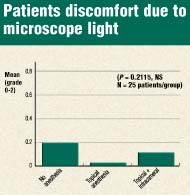 |  |
Surgeon skill
The skill and experience of the surgeon is also important. “This technique is not suitable for the beginner or less-experienced surgeon,” Dr. Pandey said. On the other hand, “a surgeon who has good control of the phacoemulsification power and is used to working with both hands is a good candidate.”
Awareness of anatomical factors, such as that the central part of the cornea is the most sensitive part, can minimize the sensation of pain. “Corneal sensitivity is reduced as you move from the central part of the cornea to the periphery,” Dr. Pandey said. “The superior part of the cornea is the least sensitive, probably because of a decreased concentration of acetylcholine.” In short, “incision and manipulations through the least sensitive part of the cornea, the superior, are probably the most important factors in success with no-anesthesia cataract surgery.” Decrease in temperature of the imaging fluid by using cold balanced salt solution can also lead to reduction in corneal sensitivity.
It has also been documented that nonwhite people have far less corneal sensitivity than white people. “Dark-brown-eyed Indians, Chinese and blacks have a corneal sensitivity that is four times less than blue-eyed Caucasians,” Dr. Pandey said. “It is possible that different quantities of anesthetics may be required according to eye color.” Likewise, frequent exposure to ultraviolet rays may result in a significant loss in corneal sensitivity. “People in developing countries such as India are more exposed to ultraviolet rays,” Dr. Pandey said.
 | 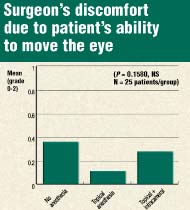 |
 |
Study results
A study coauthored by Drs. Pandey, Liliana Werner and Agarwal found no significant difference in the subjective sensation of pain during cataract surgery with or without topical anesthesia in 75 patients randomized to one of three groups (no anesthesia, topical anesthesia, topical plus intracameral). However, the stress for the surgeon during surgery was significantly greater in the no-anesthesia group compared with the other two groups.
“No-anesthesia clear corneal phacoemulsification can be performed by a highly experienced and skilled surgeon without causing unacceptable levels of pain in patients in some parts of the world, possibly due to various surgico-anatomical, environmental and racial factors,” said Dr. Pandey. “However, it is certainly not suitable for every cataract surgeon or every patient, and its real benefits have to be measured carefully on a case-by-case basis,” Dr. Pandey said.
Cordelia N. Uddoh, MD, a refractive and cataract surgeon in private solo practice in Willow Grove, Pa., had the opportunity to perform three cases of no-anesthesia cataract surgery in India in February 2000. “None of the patients felt any pain,” Dr. Uddoh said. “In one case I ran into a slight complication. I even had to touch the iris. I expected the patient to jump from the table but she didn’t.”
Dr. Uddoh said that increased tolerance to pain may be associated “with a different set of population. With their eagerness to see, perhaps they can tolerate increased discomfort.” In any event, Dr. Uddoh does not anticipate the technique will be embraced by American surgeons. When given the option, all of Dr. Uddoh’s patients chose anesthesia.
“The key point is for the patient to achieve 20/20 vision,” Dr. Agarwal said. “If you feel this can be accomplished in your hands with a peribulbar block, do it. Every surgeon need not perform no-anesthesia surgery.”
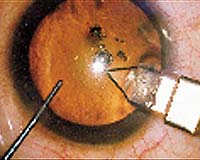 Clear corneal incision is performed. Note the straight rod in the left hand to stabilize the eye. | |
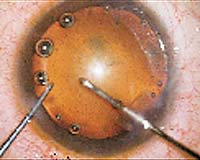 Capsulorrhexis is performed. | 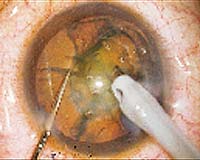 Phaco probe begins embedding the nucleus. |
 Phaco probe is embedded in the nucleus. The left hand chops the nucleus and splits it in an inverted L shape: that is, downward and to the left. |  The probe is embedded in half of the nucleus. |
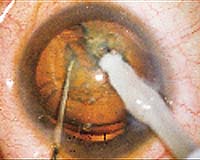 The embedded piece is pulled to prevent the rhexis from getting chopped. The nucleus is chopped and split. |  Pulsed phaco power is used to take each wedge-shaped fragment out and remove it. |
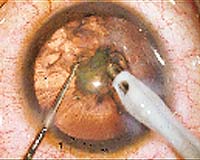 The final bits of nucleus are removed. | 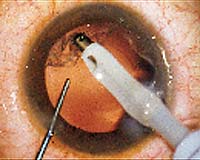 Cortical aspiration is performed. |
For Your Information:References:
- Amar Agarwal, FRCS, FRCOphth(Lon), can be reached at Dr. Agarwal’s Eye Hospital, 19 Cathedral Road, Chennai-600 086, Tamilnadu, India; (91) 44-811-6233; fax: (91) 44-811-5871; e-mail: agarwal@giasmd01.vsnl.net.in. Dr. Agarwal has no direct financial interest in any of the products mentioned in this article, nor is he a paid consultant for any companies mentioned.
- Virgílio Centurion, MD, can be reached at IMO-Instituto de Moléstias Oculares, Av. Ibirapuera, 624 - Ibirapuera, São Paulo-SP - CEP: 04028-000, Brazil; (55) 11-5084-2770; fax: (55) 11- 5084-1584; e-mail: centurion@imo.com. Dr. Centurion has no direct financial interest in any of the products mentioned in this article, nor is he a paid consultant for any companies mentioned.
- Suresh K. Pandey, MD, can be reached at Center for Research on Ocular Therapeutics and Biodevices, 167 Ashley Avenue, P.O. Box 250676, MUSC, Storm Eye Institute, Charleston, SC 29425; (843) 792-0777; fax: (843) 792-7920; e-mail: pandeys@musc.edu. Dr. Pandey has no direct financial interest in any of the products mentioned in this article, nor is he a paid consultant for any companies mentioned.
- Cordelia N. Uddoh, MD, can be reached at 608 N. Easton Road, Ste. C, Willow Grove, PA 19090; (215) 657-5044; fax: (215) 657-5046; e-mail: cuddoh@premiervision.net. Dr. Uddoh has no direct financial interest in any of the products mentioned in this article, nor is she a paid consultant for any companies mentioned.
- Pandey SK, Werner L, Agarwal A. No-anesthesia cataract surgery. In Agarwal A, ed. Phacoemulsification, laser cataract surgery and foldable IOLs. SLACK Inc., Thorofare, NJ;2000, pp 217-225.
- Pandey SK, Agarwal A, et al. A randomized clinical trial comparing no-anesthesia clear corneal phacoemulsification surgery with topical and topical plus intracameral anesthesia. J Cataract Refract Surg. 2000(submitted).
